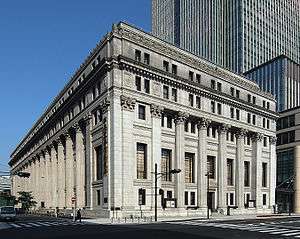Mitsui Bank
Mitsui Bank (三井銀行 Mitsui Ginko) was a major Japanese bank from 1876 to 1990. It merged with Taiyo Kobe Bank to form Mitsui Taiyo Kobe Bank (MTKB), which was renamed The Sakura Bank in April 1992. Sakura Bank is now part of Sumitomo Mitsui Banking Corporation (SMBC).
History

The Mitsui family began banking operations in 1683, when the Tokugawa Shogunate granted Mitsui Takatoshi permission to act as a money changer.
Mitsui Bank was established as a private company in July 1876, with capital of two million yen. It was one of the Japanese government's main banks for deposits and tax collections until the formation of the Bank of Japan in 1882. In ensuing decades, the Mitsui family took over numerous government industrial plants to form a major zaibatsu conglomerate, with the bank as one of its core businesses.[1] Mitsui Bank reorganized as an unlimited partnership in 1893, and as a limited company (capital stock: ¥20 million) in 1909.[2]
World War II
World War II led Mitsui Bank to distance itself from the Mitsui zaibatsu beginning around 1937, as the bank's large balance of loans to munitions manufacturers made it vulnerable to failure should a recession occur after the war. The solution found by Mitsui's chairman was to merge the bank with the Dai-Ichi Bank, creating a much larger institution outside the Mitsui family's control.[3] In April 1943, Mitsui Bank merged with Dai-Ichi to form Teikoku Bank ("Imperial Bank").[2]
Teikoku almost immediately found itself short of funds, and for the remainder of the war, mainly provided short-term financing, with long-term financing for its munitions manufacturing customers mostly provided by the Industrial Bank of Japan.[3] Dai-Ichi and Mitsui had very different corporate cultures which led to friction between the two; the two banks never completely integrated, and in October 1948, Dai-Ichi Bank separated from Teikoku Bank.[4]
Postwar era

Teikoku Bank listed its shares on the Tokyo and Osaka stock exchanges in May 1949 and changed its name back to Mitsui Bank in January 1954.[2] Mitsui Bank merged with Toto Bank in April 1968.[2]
Around 1960, Mitsui Bank and its general trading company partner Mitsui & Co. formed a horizontal keiretsu alliance between other companies descended from the Mitsui conglomerate, including Toyota, Toshiba, Toyo Menka Kaisha, Ishikawajima-Harima Heavy Industries, Showa Aircraft and Oji Paper.[5]
Mitsui established The Mitsui Bank of California in Los Angeles in 1974, and acquired Manufacturers Bank in 1981, merging the two later that year to form Mitsui Manufacturers Bank (renamed Manufacturers Bank in 1992).[6]
Mitsui Bank agreed to merge with Taiyo Kobe Bank in 1989. At the time (in the midst of the Japanese asset price bubble), the merger was to create the second largest bank in the world behind Dai-Ichi Kangyo Bank. While TKB had a strong base of individual and small business customers, Mitsui had a complementary base of larger institutional clients. The merger was aimed at leveraging these synergies, as well as providing stronger competition against European banks, which were expected to consolidate following a deregulation in 1992.[7]
References
- ↑ Yamamura, Kozo (1997). The Economic Emergence of Modern Japan, Volume 1. Cambridge University Press. p. 325.
- 1 2 3 4 "History". Sumitomo Mitsui Banking Corporation. Retrieved 7 April 2015.
- 1 2 Kasuya, Makoto (2003). Coping with Crisis: International Financial Institutions in the Interwar Period. Oxford University Press. pp. 106–108.
- ↑ Carpenter, Susan (2014). Japan Inc. on the Brink: Institutional Corruption and Agency Failure. Palgrave Macmillan. p. 49.
- ↑ "Mitsui & Co., Ltd. History". International Directory of Company Histories, Vol. 28. St. James Press, 1999. Retrieved 7 April 2015.
- ↑ "History". Manufacturers Bank. Retrieved 7 April 2015.
- ↑ "2 Japanese Banks Merging In Preparation for New Era". New York Times. 30 August 1989. Retrieved 7 April 2015.